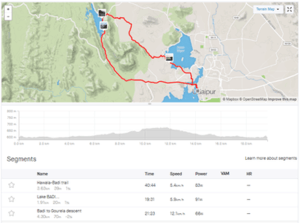Strava
Strava is an internet service for tracking human exercise which incorporates social network features. It is mostly used for cycling and running using GPS data.[5] Strava uses a freemium model with some features only available in the paid subscription plan (formerly called Strava Premium and then Strava Summit).
 A cycle ride recorded using Strava | |||||
| Developer(s) | Strava | ||||
|---|---|---|---|---|---|
| Initial release | 2009 | ||||
| Stable release |
| ||||
| Operating system | Android, iOS, Web browser | ||||
| Size | ~204.3 MB (iOS) | ||||
| Available in | 14 languages[2] English, Dutch, French, German, Italian, Japanese, Korean, Portuguese, Russian, Simplified Chinese, Spanish and Traditional Chinese[3] | ||||
| Type | Fitness | ||||
| License | Proprietary | ||||
| Alexa rank | |||||
| Website | strava | ||||
Strava Metro, a program marketed towards city planners, uses cycling data from Strava users in supported cities and regions.[6][7]
The service was founded in 2009 by Mark Gainey and Michael Horvath and is based in San Francisco, California. During the early years of Strava, both founders held CEO positions[8] before being succeeded by current CEO James Quarles who joined from Instagram.[9][10] Strava has not published numbers of its user base and paying users, although the service claimed in 2018 that it was adding one million new users every 45 days, with 8 million activities uploaded each day.[11]
Overview
Strava depends on GPS, in mobile phones or other GPS-enabled devices, to record supported activities which can be shared among user's followers or shared publicly. If an activity is publicly shared, Strava automatically groups activities together, when they occur at the same time and place (for example, taking part in a marathon/sportive or group run/ride). Each activity, depending on which activity selected, shows users' activity results, including route summary in map view form, elevation (net and unidirectional), speed (average, min/max), timing (total and moving time), power (with optional accessory) and heart rate (with optional accessory). Users may also give other users' activities "kudos", which functions as a like button, as well as leave comments.
Strava Slide is a fork of iD Editor for OpenStreetMap, which allows map editors to draw roads and trails more accurately using the same aggregated and anonymized GPS data.[12][13][14] Cycling and running traffic may be monitored by everyone on the Strava Heatmap page which shows a global heatmap.[13][15]
In July 2015, Strava switched to Mapbox maps and imagery, based on OpenStreetMap data. Strava allows users to report issues with the maps, which are linked to the OpenStreetMap editor so that users can contribute improvements to the map.[16]

Strava has a Trophy system in the form of periodic challenges that require completing either a running or cycling activity within a certain range of distance or elevation. Each activity has its own trophy badge shown in the Strava Trophy case and limited rewards if the Challenge is held by Strava partners.[17]
Paid features
In July 2018, Strava discontinued its Strava Premium subscription system and announced its replacement, Strava Summit, which divides Strava Premium benefits into three different categories,[18]
- Training
- Custom Goals
- Custom Leader-board
- Training Plans
- Race Analysis
- Segment Effort
- Safety
- Personal Heatmaps
- Beacon
- Analysis
- Power Analysis
- Workout Analysis
- Live Segments
- Relative Effort
Strava Summit includes a "Suffer Score" if heart rate data is available during an activity. The Suffer Score allows Strava to rank user activities, which is used for Strava's Training Plans and customized goals. Other features of the subscription include Beacon, live location tracking of the athlete for family and trusted friends, Live Performance Data and Live Segments, used to check real time information and compare athlete's best available record in Strava, and Strava Premium only Leader-board, Power Meter Analysis, Race Analysis, Workout Analysis, GPX Export, Personal Heatmap and Trophy Case.[19]
On 18 May 2020, Strava announced that the "Summit" branding had been dropped for the subscription service, and that personal Live Segments leaderboards on the service or on supported devices, use of the route builder, and matched runs would now require a subscription to access. In addition, third-party apps are no longer allowed API access to leaderboards.[20]
Integration
Exercises can be recorded using the mobile app, or third-party devices such as Garmin and Wahoo bike computers or smartwatches.
Controversies
In November 2017, Strava published a "Global Heatmap"—a "visualization of two years of trailing data from Strava's global network of athletes."[21] In January 2018, an Australian National University student studying international security discovered that this map had mapped military bases, including known U.S. bases in Syria, and forward operating bases in Afghanistan, and HMNB Clyde—a Royal Navy base that contains the United Kingdom's nuclear arsenal.[22][23][24][25] The findings led to continued scrutiny over privacy issues associated with fitness services and other location-aware applications; Strava's CEO James Quarles stated that the company was "committed to working with military and government officials" on the issue, and would be reviewing its features and simplifying its privacy settings.[26][27] Although users can now opt out of having their data aggregated on the global heatmap, the original data that contains sensitive information has been archived on GitHub.[28][29]
In July 2019, Strava terminated access to its APIs to Relive—a service that allows fitness data to be combined with multimedia to generate video recaps. Strava considered this to be in violation of its terms of service, which forbids the API's use with services that "replicate Strava sites, services or products", and the combination of "Strava data" with any other customer data. Relive had recently introduced social networking features; the features were subsequently removed, but Strava did not reverse its decision.[30] DC Rainmaker disputed the decision, presenting an opinion that "Strava data" constituted personally-identifiable information under the European Union General Data Protection Regulation (GDPR), meaning that users had rights to control how it is used by Strava—including third-party processing that they had already agreed to by linking Relive to Strava, and noted other examples of similar services (such as Trailforks) engaging in similar if not more extensive use of "Strava data", and that Strava had previously endorsed Relive on several occasions.[31]
In October 2019, Strava announced that Bluetooth and ANT+ sensors would no longer pair directly with the Strava mobile app which caused some consternation from its users.[32]
See also
- AllTrails
- Endomondo
- Google Fit
- Health (Apple) (aka Apple Health)
- Runtastic
- Samsung Health
References
- "Strava: Run, Ride, Swim". App Store. Retrieved October 30, 2019.
- "Changing your language in the Strava App". Strava. Retrieved November 10, 2018.
- https://apps.apple.com/us/app/strava-run-ride-swim/id426826309
- "Strava.com Traffic, Demographics and Competitors - Alexa". www.alexa.com. Retrieved October 1, 2019.
- "Supported Activity Types on Strava". Strava Support. Retrieved November 10, 2018.
- Walker, Peter (May 9, 2016). "City planners tap into wealth of cycling data from Strava tracking app". The Guardian. Retrieved November 10, 2018.
- MacMichael, Simon (May 7, 2014). "Strava moves into 'big data' - London & Glasgow already signed up to find out where cyclists ride". Road.cc. Retrieved December 1, 2014.
- "Carpe diem". Retrieved November 10, 2018.
- Lindsey, Joe (June 24, 2019). "Strava Is Booming. Just Don't Call It the Facebook of Fitness". Outside Online. Retrieved September 14, 2019.
- "Strava Names James Quarles as CEO". Retrieved November 10, 2018.
- Goode, Lauren. "Fitness app Strava really, really wants to be the social network for athletes". The Verge. Retrieved August 24, 2018.
- Mach, Paul (April 12, 2014). "Slide: Auto-drawing Geometry to Remove the Pains of Map Tracing". Retrieved December 1, 2014.
- Clarke, Keir (April 29, 2014). "Mapping the Burn with Strava Labs". Maps Mania. Retrieved December 2, 2014.
- "Strava Labs Slide". Strava.com. Retrieved December 2, 2014.
- "Strava Global Heatmap". Strava.com. Retrieved December 2, 2014.
- "Feedback for Strava's new maps (OpenStreetMap)". zendesk.com. Retrieved March 14, 2017.
- "Strava - Challenges". strava.com. Retrieved March 14, 2017.
- "Goodbye, Premium. Hello, Summit". Retrieved August 24, 2018.
- "Make the most of your sport". January 28, 2018. Archived from the original on January 28, 2018. Retrieved November 14, 2018.
- "Strava Cuts Off Leaderboard for Free Users, Reduces 3rd Party Apps for All, and More". DC Rainmaker. May 18, 2020. Retrieved May 19, 2020.
- Robb, Drew (April 4, 2018). "Building the Global Heatmap - strava-engineering". Strava Engineering. Retrieved July 13, 2019.
- Hern, Alex (January 23, 2018). "Fitness tracking app gives away location of secret US army bases". The Guardian. Retrieved January 28, 2018.
- "Fitness tracker highlights military bases". BBC News. 2018. Retrieved January 29, 2018.
- "Strava Endangering the Military Accidentally". Crash Security. January 28, 2018. Retrieved May 21, 2018.
- Liptak, Andrew (January 28, 2018). "Strava's fitness tracker heat map reveals the location of military bases". The Verge. Retrieved July 13, 2019.
- "Strava's fitness heatmaps are a 'potential catastrophe'". Engadget. Retrieved July 13, 2019.
- "Strava will focus on privacy awareness to address security issues". Engadget. Retrieved July 13, 2019.
- Hern, Alex (January 29, 2018). "Strava suggests military users 'opt out' of heatmap as row deepens". The Guardian. Retrieved April 2, 2020.
- Schwartz, Mathew (January 28, 2018). "Feel the Heat: Strava 'Big Data' Maps Sensitive Locations". www.bankinfosecurity.com. Retrieved April 2, 2020.
- "Your Strava rides will no longer be shared with Relive". Android Central. July 11, 2019. Retrieved July 18, 2019.
- "Strava Cuts off Relive: Here's what actually happened".
- Murnane, Kevin. "Strava Drops A Popular Feature And Drives Users Away [Updated With A Response From Strava]". Forbes. Retrieved October 27, 2019.